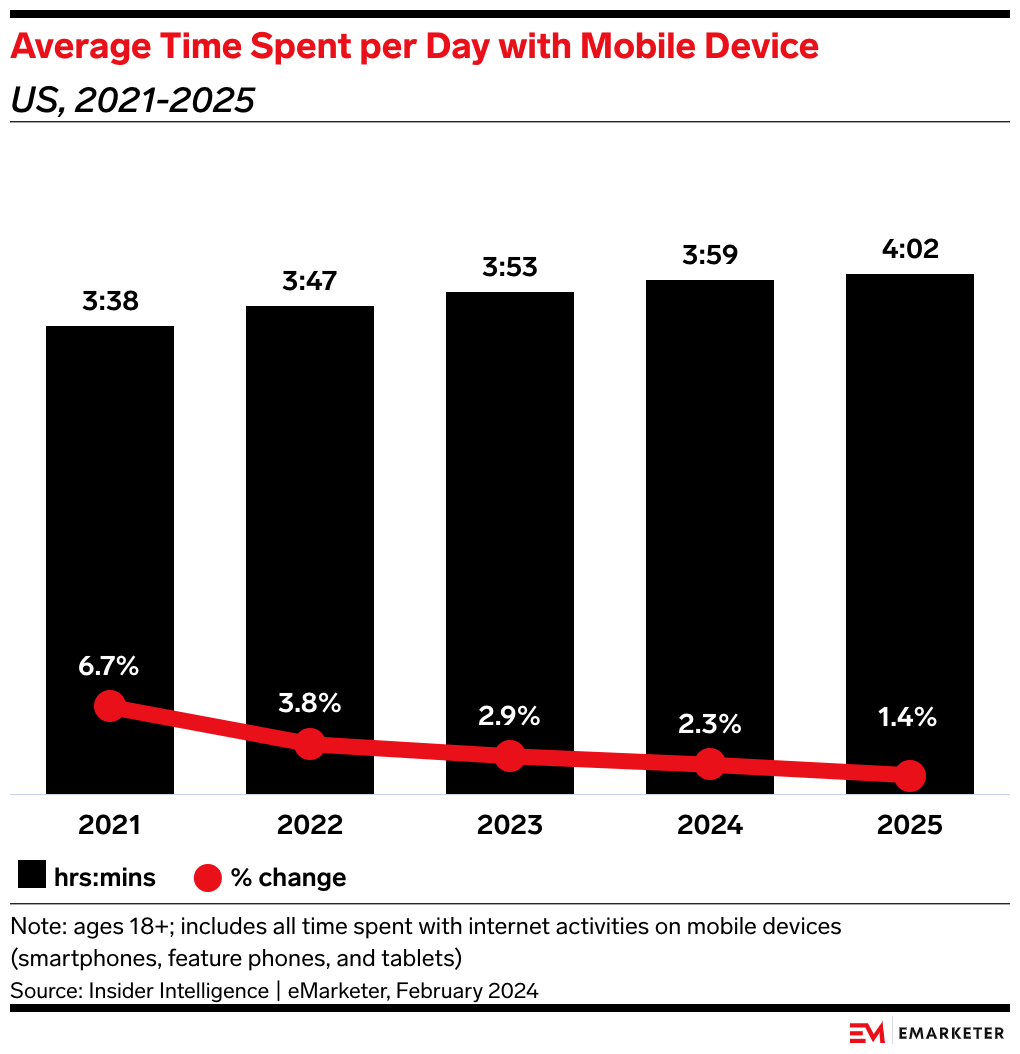In the last decade, digital advertising has transformed dramatically with mobile’s rise. In 2023, US adults spent nearly a third of their media time on mobile (31.5%), increasing nearly double from its 2023 share (16.2%), according to EMARKETER’s October 2023 forecast. This shift has led to audience fragmentation across digital platforms, emphasizing the need for mobile-focused ad strategies. Advertisers are responding, with mobile digital ad spend jumping to 49.3% of total media ad spend, a substantial rise from 5.9% in 2013.
In this guide, we discuss these changes, the benefits of mobile advertising, and the size of the market.
- Want to learn more about mobile advertising and other marketing trends? Sign up for the EMARKETER Daily newsletter.
Mobile advertising refers to any form of advertising that takes place on a smartphone or tablet. This mode of advertising is efficient and budget-friendly. Given that consumers consistently interact with their mobile devices, brands require an online presence to garner attention from mobile users.
As ad design innovation continues to advance over time, mobile advertising will be invaluable for businesses looking to retain customers, attract new audiences, and sustain long-term growth. Advertisers using mobile ads must prioritize the user experience, due to the limited screen space on mobile phones compared with desktops.
A chart showing mobile ad spending in the US, 2023-2025. (Subscribers only)
An accessible, hyper-targeted audience
People carry their phones everywhere, making targeting approaches like location-based mobile advertising (leveraging a user’s location to offer tailored ads or offers) effective. This tactic often boosts clickthrough and conversion rates. Geo-targeting is a popular location-centric strategy, offering even more precision in targeting. For example, a retailer that sells baking equipment might send push notifications to an individual who recently visited a bakery.
Easier tracking of campaign performance
Mobile marketing results are fairly simple to track, particularly with the help of tools that measure behaviors like website visits and clickthrough rates, allowing marketers to refine messaging to increase reach and boost ROI.
Lower cost
Mobile marketing is often cost-effective to produce, and its tracking capabilities can help reduce costs—for example, if a campaign isn’t effective, it can be quickly paused. Budget-friendly campaign tactics, such as bulk text messaging campaigns, can be valuable for small and medium-sized businesses.
Banner ads
Banner ads feature elements like a headline, copy, and call to action and typically appear at the top or bottom of website pages or mobile apps, according to Amazon Ads. This is a popular approach as it is cost-effective, easy to implement, and supported across various devices.
Video ads
As video gets increasingly popular among mobile device users, more brands are leveraging video in their marketing strategies. Per Amazon Ads, video ad types include:
- In-stream video ads: These ads play before, during, and after a video is watched.
- Interstitial video ads: This ad type involves a pop-up of a short video clip and may cover the entire screen.
- In-app video ads: This type of ad appears more organic than a sponsored ad as users encounter it while scrolling through their social media app feeds.
- Gamified video ads: This ad type provides an interactive mobile experience, enabling users to interact with an ad by playing a short game. High conversion rates can be achieved when users find these ads engaging or informative.
Native ads
Native ads are a less traditional form of advertising, where an advertiser aims to create an organic experience for their audience. This type of ad offers an enhanced, authentic experience with limited disruption.
Mobile app monetization
There are two ways to monetize a mobile app: in-app purchases (IAPs) and in-app advertising (IAA).
IAPs: These are for thing like virtual goods, subscriptions, in-game currency, and premium content. “Virtual goods sales in gaming have historically generated most IAPs and still represent a majority. That will end in 2025,” EMARKETER analyst Yoram Wurmser wrote in our Mobile App Monetization 2023 report. “Overall, gaming IAPs will still be larger than nongaming, including both virtual goods and subscriptions, through the end of our forecast—but barely.”
IAA: This is advertising in a mobile app, including video, search, and shopping ads. “Mobile advertising will keep growing at a rapid clip despite headwinds from privacy laws and [generative] AI. Even so, app publishers will explore additional ways of making money for premium content. This may have an impact on the type and price of ad inventory in the future, although the volume of IAA should remain strong,” according to the Mobile App Monetization 2023 report.
Across 10 industries—entertainment, telecom, computing products and consumer electronics, consumer packaged goods (CPG), financial services, retail, media, automotive, travel, and healthcare and pharma—mobile advertising was used over nonmobile advertising, per an August 2023 EMARKETER forecast.
US industries will spend 66% of digital ad spend on mobile in 2024. Mobile ad spend has leveled off since 2022 as connected TV (CTV) has gained market share. US CTV ad spend is expected to increase 22.4% YoY in 2024, reaching $30.10 billion, and is expected to maintain double-digit increases annually until 2027.
While no industry experienced explosive ad spend growth in 2023, there are positive mobile trends to highlight, according to EMARKETER’s US Digital Ad Spending by Industry 2023 report. Sectors like travel, retail, healthcare and pharma, and auto are set to grow faster than the national average, with entertainment rising just ahead of the average growth rate.
Moreover, a few sectors that saw diminished spending in 2022 are poised for notable recoveries. Both auto and CPG are expected to see substantial increases in ad spending in 2023 and 2024 relative to 2022. Meanwhile, financial services are expected to receive a more significant bump in 2024.
IAPs—which include both subscription fees and virtual goods in mobile games and media—will grow 3.5% in 2024, per our July 2023 forecast. Almost three-quarters (74.4%) of in-app revenues in nongaming come from subscriptions, and this percentage will continue to grow through 2027.
“Privacy restrictions on iOS and Android continue to tighten,” per our Mobile App Monetization 2023 report. And while advertisers have been able to find clever ways around this, privacy and antitrust regulations may pose a greater threat in time, which could make third-party app stores more appealing and take away from app store commissions. Another mobile ad trend to watch will be generative AI’s impact on search, which could decrease site traffic.
Despite challenges from privacy regulations and generative AI, mobile advertising is poised to continue growing rapidly. App publishers will likely explore new methods for monetization, including offering access to features like AI chatbots, which could influence the nature and cost of future ad spaces. However, the demand for IAA is expected to continue over the next few years.
Time spent on smartphones by US adults increased by 17.7% to reach 3 hours and 2 mins (3:02) in 2020, up from 2:34 in 2019, influenced by subscription video-on-demand, TikTok, podcasts, and pandemic dynamics, according to our US Time Spent with Connected Devices 2022 report.
This rise in smartphone usage will extend into the coming years, albeit more slowly. Smartphone usage growth is expected to stabilize, growing 2.1% to 3:31 in 2024, up slightly from 3:26 in 2023.
 A chart showing time spent with mobile in the US, 2023-2025. (Subscribers only)
A chart showing time spent with mobile in the US, 2023-2025. (Subscribers only)
Adoption of 5G broadband in the US is projected to reach 290.5 million device subscriptions by 2026, despite a slower-than-anticipated initial rollout, according to EMARKETER’s State of 5G report. The expansion of 5G is poised to optimize inventory management for retailers, enhance in-store and online shopping, and boost mobile AR experiences for consumers. Marketers can leverage these advancements for more dynamic digital advertising and deeper insights into consumer behaviors.
The app landscape is shifting as users consolidate their preferences, opting for fewer but more versatile apps. This change indicates the possible ascent of super apps in the West, mirroring the model used in Asia-Pacific, according to our Mobile App Users 2023 report.
In addition, grocery apps stand out as the fastest-growing segment, with an expected compound annual growth rate of 5.23% between 2023 and 2026. The rise in grocery apps, along with other niche sectors like banking and dating, has created fresh advertising prospects beyond leading platforms like Meta, Google, and Amazon. Marketers also have the chance to harness valuable first-party data to fine-tune their advertising approaches.
As smartphone use increases, so too do mcommerce sales. In 2024, US retail mcommerce sales will reach $542.66 billion, accounting for 7.3% of total retail sales, according to a February 2024 EMARKETER forecast. Further, mcommerce is estimated to make up 44.6% of total US retail ecommerce sales in 2024.
EMARKETER’s Future of Digital 2024 report delves into changes discussed in this guide, highlighting the critical role of mobile in digital advertising’s evolution. Download the report to understand these decade-long shifts and how to adapt your advertising strategies for this mobile-centric era.




